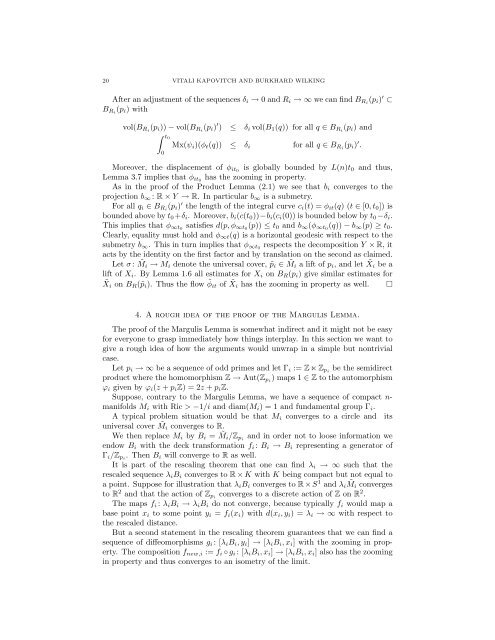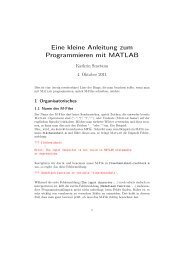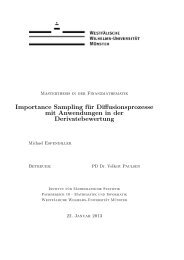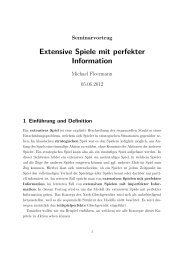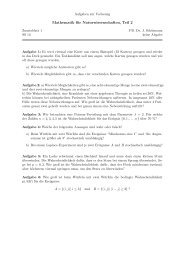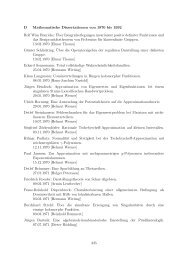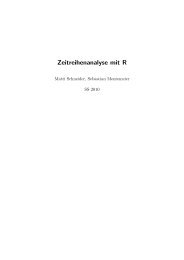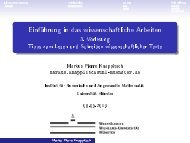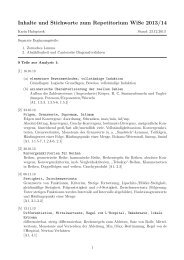Margulis Lemma
Margulis Lemma
Margulis Lemma
Create successful ePaper yourself
Turn your PDF publications into a flip-book with our unique Google optimized e-Paper software.
20 VITALI KAPOVITCH AND BURKHARD WILKING<br />
After an adjustment of the sequences δ i → 0 and R i → ∞ we can find B Ri (p i ) ′ ⊂<br />
B Ri (p i ) with<br />
vol(B Ri (p i )) − vol(B Ri (p i ) ′ ) ≤ δ i vol(B 1 (q)) for all q ∈ B Ri (p i ) and<br />
∫ t0<br />
0<br />
Mx(ψ i )(φ t (q)) ≤ δ i for all q ∈ B Ri (p i ) ′ .<br />
Moreover, the displacement of φ it0 is globally bounded by L(n)t 0 and thus,<br />
<strong>Lemma</strong> 3.7 implies that φ it0 has the zooming in property.<br />
As in the proof of the Product <strong>Lemma</strong> (2.1) we see that b i converges to the<br />
projection b ∞ : R × Y → R. In particular b ∞ is a submetry.<br />
For all q i ∈ B Ri (p i ) ′ the length of the integral curve c i (t) = φ it (q) (t ∈ [0, t 0 ]) is<br />
bounded above by t 0 +δ i . Moreover, b i (c(t 0 ))−b i (c i (0)) is bounded below by t 0 −δ i .<br />
This implies that φ ∞t0 satisfies d(p, φ ∞t0 (p)) ≤ t 0 and b ∞ (φ ∞t0 (q)) − b ∞ (p) ≥ t 0 .<br />
Clearly, equality must hold and φ ∞t (q) is a horizontal geodesic with respect to the<br />
submetry b ∞ . This in turn implies that φ ∞t0 respects the decomposition Y × R, it<br />
acts by the identity on the first factor and by translation on the second as claimed.<br />
Let σ : ˜Mi → M i denote the universal cover, ˜p i ∈ ˜M i a lift of p i , and let ˜X i be a<br />
lift of X i . By <strong>Lemma</strong> 1.6 all estimates for X i on B R (p i ) give similar estimates for<br />
˜X i on B R (˜p i ). Thus the flow ˜φ it of ˜Xi has the zooming in property as well. □<br />
4. A rough idea of the proof of the <strong>Margulis</strong> <strong>Lemma</strong>.<br />
The proof of the <strong>Margulis</strong> <strong>Lemma</strong> is somewhat indirect and it might not be easy<br />
for everyone to grasp immediately how things interplay. In this section we want to<br />
give a rough idea of how the arguments would unwrap in a simple but nontrivial<br />
case.<br />
Let p i → ∞ be a sequence of odd primes and let Γ i := Z ⋉ Z pi be the semidirect<br />
product where the homomorphism Z → Aut(Z pi ) maps 1 ∈ Z to the automorphism<br />
ϕ i given by ϕ i (z + p i Z) = 2z + p i Z.<br />
Suppose, contrary to the <strong>Margulis</strong> <strong>Lemma</strong>, we have a sequence of compact n-<br />
manifolds M i with Ric > −1/i and diam(M i ) = 1 and fundamental group Γ i .<br />
A typical problem situation would be that M i converges to a circle and its<br />
universal cover ˜M i converges to R.<br />
We then replace M i by B i = ˜M i /Z pi and in order not to loose information we<br />
endow B i with the deck transformation f i : B i → B i representing a generator of<br />
Γ i /Z pi . Then B i will converge to R as well.<br />
It is part of the rescaling theorem that one can find λ i → ∞ such that the<br />
rescaled sequence λ i B i converges to R × K with K being compact but not equal to<br />
a point. Suppose for illustration that λ i B i converges to R × S 1 and λ i ˜Mi converges<br />
to R 2 and that the action of Z pi converges to a discrete action of Z on R 2 .<br />
The maps f i : λ i B i → λ i B i do not converge, because typically f i would map a<br />
base point x i to some point y i = f i (x i ) with d(x i , y i ) = λ i → ∞ with respect to<br />
the rescaled distance.<br />
But a second statement in the rescaling theorem guarantees that we can find a<br />
sequence of diffeomorphisms g i : [λ i B i , y i ] → [λ i B i , x i ] with the zooming in property.<br />
The composition f new,i := f i ◦ g i : [λ i B i , x i ] → [λ i B i , x i ] also has the zooming<br />
in property and thus converges to an isometry of the limit.


